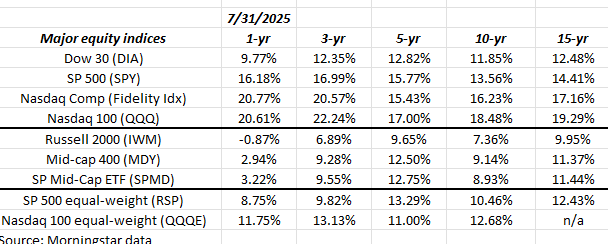In the heart of summertime client meetings and those scheduled for January 2025, a prominent topic of discussion among advisors and their clients has been the ongoing secular bull market of the past 15 years. Queries and contemplations revolved around the longevity of this market trend, speculating on how much more it could extend and what the landscape might look like when eventually it peaks and trends shift.
Delving into the Historical Context of Market Fluctuations
Rewinding to the immediate aftermath of World War II in 1945, as Japan surrendered, predictions of economic downturn loomed large. Economists forewarned of a potential replay of the Great Depression, fearing the mass return of troops would swamp a job market already at its capacity. However, contrary to these grim forecasts, the United States embarked on a prolonged period of economic prosperity. The Dow Jones Industrial Average (DJIA), the leading market index of the era, embarked on a relentless ascent, marking a bull run that spanned twenty-three years from 1942 to 1965, post which the market saw a period of stabilization rather than growth, extending into the early 1980s.
The intervening period from 1965 to 1980 was marred by significant socio-political turbulence including the protraction of the Vietnam War, the Nixon presidency marred by the scandal of Watergate, the Arab Oil Embargo leading to a spike in gasoline prices, and geopolitical instabilities like the Iran Hostage Crisis. The market wasn’t immune to these upheavals, witnessing its first major bear phase in 1973-1974, heavily influenced by the Watergate scandal among other factors.
However, this was to precede what would become the most monumental bull stock market in U.S. history from 1982 to 2000, driven notably by the technological revolution. This era saw the advent and proliferation of personal computing, enhancing corporate productivity, which then gave way to the explosion of the internet – a transformative period in technology akin to the invention of the printing press.
The dawn of the new millennium until 2009, however, was a period of notable stagnation for the S&P 500, with an annual return averaging around 1.5%. This era saw two significant bear markets that corrected the overvaluation in the tech sector and then the excesses in the housing market. Yet, from the lows of March 9th, 2009, a new bull market emerged, its inception debated to be either from this trough or the point in early May 2013 when the S&P 500 finally surged past its previous highs.
Analysing the Current Secular Bull Market Through a Comparative Lens
When drawing parallels between the bull markets of 1982-2000 and the ongoing bullish trend from 2009, several similarities emerge, notably in sector leadership and market cap concentration. The technology and financial sectors have played pivotal roles in driving growth during both periods. As of recent data, technology stocks, alongside financials, significantly contribute to the S&P 500’s market cap, exemplifying a trend that mirrors the late ’90s. Furthermore, the pivotal role of technological innovation continues to underpin market growth, with companies leading in AI and the consumer technology boom, taking the baton from previous innovations in personal computing and the internet.
However, distinct differences also mark the present market compared to the ’90s boom. Today’s market sentiment oscillates rapidly between extremes of greed and fear, a contrast to the bullish unidirectionality of the ’90s. Additionally, the composition and quality of earnings within technology sector holdings reveal a healthier financial ecosystem, indicating a more sustainable foundation for growth.
As we stand, the longevity and eventual culmination of the current bull market remain subjects of speculation. The transition of decades historically marks shifts in market trends, suggesting possible continuance or shift in the coming years. Strategic portfolio diversification remains paramount, with advisors considering “non-correlated” assets to hedge against volatility and enhance returns. Such strategies might include investments in sectors or assets lagging behind the benchmarks, offering a counterbalance to high-growth areas.
In conclusion, while the vibrancy of the stock market continues to captivate investors, drawing lessons from historical patterns and adopting a measured approach to portfolio diversification can provide a prudent path forward in navigating the uncertainties that lie ahead. With market dynamics perpetually in flux, adaptability and foresight emerge as indispensable tools for investors aiming to capitalize on opportunities while mitigating risks. As always, this discourse serves to enlighten and not prescribe, underscoring the importance of individual due diligence and risk assessment in investment decision-making.
We hope this exploration offers valuable insights and a broader perspective on the intricate dynamics at play within the stock market’s historical and current trends. Thank you for taking the time to engage with this analysis.



